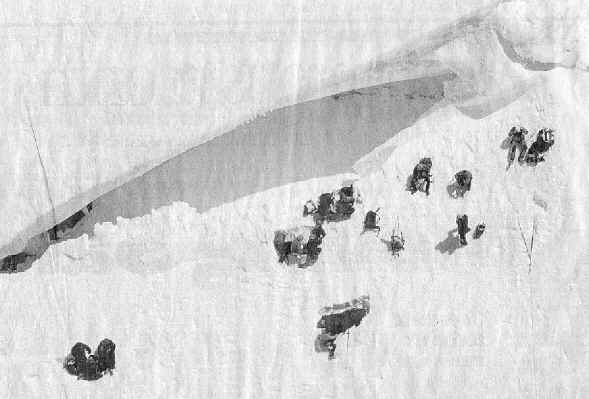 ™
™TRADITIONAL MOUNTAINEERING
™
www.TraditionalMountaineering.org
™ and also
www.AlpineMountaineering.org
™
 ™
™
FREE BASIC TO ADVANCED
ALPINE MOUNTAIN CLIMBING INSTRUCTION™
Home
| Information
| Photos
| Calendar
| News
| Seminars
| Experiences
| Questions
| Updates
| Books
| Conditions
| Links
| Search
![]()

MOUNTAIN CALAMITY BRINGS SAFETY TO THE FORE
Calculated Risks, Experience Can Help Save Climbers Lives
Jim Witty
The Bulletin, Saturday, June 1, 2002
When people set out to climb a mountain, danger is always part of the equation. They can minimize it with common sense, training and proper tools, but they can’t completely eliminate it.
“Risk is an integral part of mountaineering,” says longtime peakbagger and wilderness skills instructor Bob Speik of Bend. “Mitigation of risk by training, experience and marvelous equipment is essential.”
But the literature of mountaineering is dominated by harrowing accounts of accidents at altitude. While not commonplace, Thursday’s accident on Mount Hood was by no means unique. There have been 130 fatalities in the past 100 years on Mount Hood. And 11 of the last 25 people killed on Mount Hood died in May, a month with mild weather and hordes of climbers.
Mount Hood, Oregon’s tallest peak at 11,200 feet, is one of the most heavily climbed mountains in the world
“It’s fairly forgiving because somebody will know what to do,” said Speik, speaking generally, not specifically, about the tragedy on Mount Hood. “One experienced person can hold a slide of several people, (tethered together) with an ice ax.”
But conditions can conspire to make arresting a slide extremely difficult, if not impossible.
“You have to have respect for steep snow slopes,” said Speik. “You need to know what you are doing. It’s like walking on the edge of a cliff several hundred feet tall. The only difference between falling off the cliff and falling down a steep snow slope is the friction of your clothing on the snow.”
That’s where an ice ax comes in.
“Once you start a slide you have to stop it immediately or you’re going to develop so much speed that you can’t stop,” Speik explained. “People get so much speed that they start flailing and it’s like a Raggedy Ann doll.”
The ice ax self-belay is the climber’s first line of defense. Experienced mountaineers are trained to shove the shaft into the snow and to grasp it at the sheer line – right at snow level. On hard snow, the self-belay must be performed quickly, before momentum builds. In soft conditions, the self-belay often does no good because the ax can’t get a proper grip.
Any way you come at it, “Your adhesion to the snow is very tenuous,” Speik said.
And that makes most climbs in the Cascades more than a hike. They require knowledge, planning and, in most cases, specialized equipment.
A case in point: On July 5, 1998, Martina Testa, a German national who had been climbing in Oregon for less than a year, headed alone for the summit of North Sister.
She died after sliding and tumbling on a (surface softened) hard, steep (snow) slope.
“Make no mistake, Mount Hood is a technical climb, not a hike,” said Speik “South Sister in the summer is a hard hike. There just aren’t any mountains in the Three Sisters Wilderness that aren’t technical except for the South Ridge Route on South Sister.”
That’s because things can get real tricky real fast in the high mountains.
“Climbing at Smith Rock (north of Redmond) has been simplified down to mechanics,” Said Speik. “They’ve eliminated every kind of risk except mechanical. But in mountaineering, you have the risk of weather, injury far from emergency medical service, avalanche and rock fall.”
Even so, as long as there are mountains, there will be people who are driven to scale them.
If you’re one, seek out the necessary technical training. Two Web sites that will help are
www.TraditionalMountaineering.org and www.cascadesmountaineers.org.
“Taking basic and advanced seminars and classes and climbing with trained and experienced partners is the best way to learn advanced skills and judgment,” said Speik. “Experience tells us that warm spring weather can soften a steep snow slope, making a slip likely and an arrest impossible.”
Matt Stalter of Bend, an intermediate climber with a few peaks under his belt, was sobered by the latest accident on Mount Hood.
“Even the safe stuff has the potential for disaster,” he said. “Even with South Sister, if you don’t understand lightening strikes, you can get zapped. There lots of ways a mountain can kill you.”
![]()
Read more
Mount Hood - Sheriff's
Final Report and our analysis
Mount Hood -
helicopter crashes during rescue
Mount Hood - incident causes safety concerns
Mount Hood - fatal fall on soft snow
Mount Hood - fatal fall on Cooper
Spur
Mount Hood - fatal slip on hard snow
from the summit
Mount Hood - avalanche fatal to
student climbers
Mount Hood - lucky novice rescued
Mount Hood - lost on the mountain
Mount Shasta - slip on hard snow
What about
climbing Mount Hood?
How to Travel over steep snow
Learning to climb steep hard snow slopes
5 pdf pages
Learning roped travel and ice axe arrest
South Sister spring climb for
gear and techniques
American Alpine Club
Oregon Section of the AAC
Accidents in North American Mountaineering